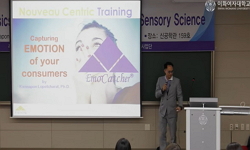정서가 초점주의에 미치는 영향을 알아보기 위해 배경자극으로 제시된 그림자극의 정서가가 수반자극과제 수행에 미치는 효과를 조사하였다. 수반자극이 표적자극과 상이한 경우와 동일한...
http://chineseinput.net/에서 pinyin(병음)방식으로 중국어를 변환할 수 있습니다.
변환된 중국어를 복사하여 사용하시면 됩니다.
- 中文 을 입력하시려면 zhongwen을 입력하시고 space를누르시면됩니다.
- 北京 을 입력하시려면 beijing을 입력하시고 space를 누르시면 됩니다.
https://www.riss.kr/link?id=A60018280
- 저자
- 발행기관
- 학술지명
- 권호사항
-
발행연도
2011
-
작성언어
Korean
-
주제어
수반자극과제 ; 정서 ; 초점주의 ; 주의범위 ; flanker task ; emotion ; focused attention ; scope of attention
-
KDC
181.305
-
등재정보
KCI등재
-
자료형태
학술저널
- 발행기관 URL
-
수록면
385-404(20쪽)
-
KCI 피인용횟수
3
- DOI식별코드
- 제공처
-
0
상세조회 -
0
다운로드
부가정보
국문 초록 (Abstract)
정서가 초점주의에 미치는 영향을 알아보기 위해 배경자극으로 제시된 그림자극의 정서가가 수반자극과제 수행에 미치는 효과를 조사하였다. 수반자극이 표적자극과 상이한 경우와 동일한 경우의 반응속도 차이(부합성효과)는 수반자극 처리에 의한 간섭, 즉 표적자극에 대한 초점주의의 실패를 의미하는데, 부합성효과에 미치는 배경 그림자극의 정서가(긍정, 중립, 부정) 효과를 분석 하였다{실험 1). 그 결과, 부합성효과의 크기는 표적자극과 수반자극간 거리(시각 0.6도, 1도, 1.6도)뿐만 아니라 배경 그림자극의 정서가의 영향을 함께 받았는데, 중립과 긍정 그림 배경에서는 거리가 멀수록 부합성효과가 감소한 반면(거리효과), 부정 그림 배경에서는 거리효과가 관찰되지 않았다. 또한 배경 그림자극과 표적/수반자극 간 SOA(100ms, 2800ms)와 거래시각 0.6도, 1.6도)를 변화시켜 부합성에 미치는 효과를 조사한 결과, 정서가에 따른 거리효과가 SOA에 따라 상이하였다(실험 2). SOA가 긴 경우, 중립과 긍정 그림 배경에서는 거리효과가 관찰되었으나, 부정 그림 배경에서는 거리효과가 관찰되지 않았다. 그리고 부합성효과가 모든 정서가에서 먼 거리와는 달리 가까운 거리에서만 유의미했다 반면, SOA가 짧은 경우에는 모든 정서가에서 거리효과가 관찰 되었으며, 부합성효과가 중립과 긍정 그림 배경에서는 두 거리조건 모두에서 유의미했지만 부정 그림 배경에서는 먼 거리에서 유의미하지 않았다. 이 결과는 전반적으로 부정정서에 의한 시각적 주의범위의 축소와 긍정정서에 의한 주의범위의 확산을 시사하는데, 특히 후자가 전자에 비해 더 일시적이라는 것을 시사한다.
다국어 초록 (Multilingual Abstract)
We examined how emotional background stimuli influence focused attention in a flanker task. An lAPS picture was presented for 1, 000ms in advance, then a target and cwo flanker lerrers were presented against the lAPS picture for 200ms(Experiment I). T...
We examined how emotional background stimuli influence focused attention in a flanker task. An lAPS picture was presented for 1, 000ms in advance, then a target and cwo flanker lerrers were presented against the lAPS picture for 200ms(Experiment I). The flanking stimuli were simultaneously presented on the left and right sides of the target stimulus with distance of 0.6°, 1°, Or 1.6° visual angle. We investigated the flanker compatibility effect that identification of target would be faster when they were flanked by idenricak(cornpatible) stimuli than when they were flanked by differenrt(incornparible) stimuli. Results of Experiment I revealed that the flanker compatibility effect depended not only on the distance of flankers bur also on the valence of a background lAPS pictures. Positive and neutral pictures showed distance effect that the flanker compatibility effect was decreased as the farther the distance was, while negative pictures showed no distance effect. Positive and neutral pictures showed compat ibility effects at all distance conditions, but negative pictures didn't showed compatibility effect at 1.6° distance condition. In Experiment 2, the SOA(Stimulus Onset Asynchrony) between the picture and the stimuli of flanker task was manipulated. The flanking stimuli were presented simultaneously on the left and right sides of the target stimulus with a distance of either 0.6° or 1.6° visual angle. The results of Experiment 2 showed that flanker compatibility effect depends on SOA. At long SOA(2800ms), negative pictures showed no distance effect, bur positive or neutral pictures did. All valence conditions of background pictures showed compatibility effects at 0.6° distance condition, but didn't showed compatibility effecr at 1.6° distance condition. At shorr SOA(100ms), all valence conditions of background pictures showed distance effect, and showed compatibility effects with the exception of negative background pictures at 1.6° distance condition. These findings suggest that the scope of visual attenti on becomes narrower when viewing negative emotional stimuli and becomes broadened when viewing positive emotional stimuli. The narrowed scope of attention in negative emotion lasts longer, while the broaden scope of attention in positive emotion lasts shorter.
목차 (Table of Contents)
- 실험 1: 자극의 정서가가 시각적 주의범위에 미치는 영향
- 방법
- 결과
- 실험 2: 정서자극과 표적/수반자극 간 SOA가 주의범위에 미치는 영향
- 방법
- 실험 1: 자극의 정서가가 시각적 주의범위에 미치는 영향
- 방법
- 결과
- 실험 2: 정서자극과 표적/수반자극 간 SOA가 주의범위에 미치는 영향
- 방법
- 결과
- 종합논의
- 참고문헌
- Abstract
참고문헌 (Reference)
1 Fredrickson, B. L, "What good are positive emotions" 2 : 300-319, 1998
2 Kramer, "Weapon focus, arousal, and eyewitness memory" 14 : 167-184, 1990
3 Eriksen, C. W, "Visual attention within and around the field of focal attention: A zoom lens model" 40 : 225-240, 1986
4 Fredrickson, B. L, "The role of positive emotions in positive psychology: The broaden-and-build theory of positive emotions" 56 : 218-226, 2001
5 Nobata, T, "The functional field of view becomes narrower while viewing negative emotional stimuli" 24 : 886-891, 2010
6 Oue, W, "The effect of negative emotion on eyewitness functional field of view" 72 : 361-368, 2001
7 Easterbrook, J. A, "The effect of emotion on the utilization and the organization of behaviour" 66 : 183-201, 1959
8 Rueda, M. R, "The development of executive attention: Contributions to the emergence of self-regulation" 28 : 573-594, 2005
9 Dong, G, "The course of visual searching to a target in a fixed location: Electrophysiological evidence from an emotional flanker task" 460 : 1-5, 2009
10 Bluck, S, "Predicting memory completeness and accuracy: Emotion and exposure in repeated autobiographical recall" 15 : 145-158, 2001
1 Fredrickson, B. L, "What good are positive emotions" 2 : 300-319, 1998
2 Kramer, "Weapon focus, arousal, and eyewitness memory" 14 : 167-184, 1990
3 Eriksen, C. W, "Visual attention within and around the field of focal attention: A zoom lens model" 40 : 225-240, 1986
4 Fredrickson, B. L, "The role of positive emotions in positive psychology: The broaden-and-build theory of positive emotions" 56 : 218-226, 2001
5 Nobata, T, "The functional field of view becomes narrower while viewing negative emotional stimuli" 24 : 886-891, 2010
6 Oue, W, "The effect of negative emotion on eyewitness functional field of view" 72 : 361-368, 2001
7 Easterbrook, J. A, "The effect of emotion on the utilization and the organization of behaviour" 66 : 183-201, 1959
8 Rueda, M. R, "The development of executive attention: Contributions to the emergence of self-regulation" 28 : 573-594, 2005
9 Dong, G, "The course of visual searching to a target in a fixed location: Electrophysiological evidence from an emotional flanker task" 460 : 1-5, 2009
10 Bluck, S, "Predicting memory completeness and accuracy: Emotion and exposure in repeated autobiographical recall" 15 : 145-158, 2001
11 Rowe, G, "Positive affect increases the breadth of attentional selection" 104 : 383-388, 2007
12 Dennis, T. A, "Neurophysiological mechanism in the emotional modulation of attention: The interplay between threat sensitivity and attentional control" 76 : 1-10, 2007
13 Heil, M, "N200 in the eriksen-task: Inhibitory executive processes" 14 : 218-225, 2000
14 Derryberry, D, "Motivating the focus of attention in The heart’s eye: Emotional influences in perception and attention" San Dieago, CA: Academic Press 167-196, 1994
15 Fenske, M. J, "Modulation of focused attention by faces expressing emotion: Evidence from flanker tasks" 3 : 327-343, 2003
16 Lang, P. J, "International Affective Picture System(IAPS): Affective ratings of Pictures and instruction manual" University of Florida, Gainesville. FL 2005
17 박태진, "IAPS 자극에 대한 한국 대학생의 정서 평가" 한국인지과학회 20 (20): 183-195, 2009
18 Horstmann, G, "Flanker effects with faces may depend on perceptual as well as emotional differences" 6 : 28-39, 2006
19 Eriksen, B. A, "Effects of noise letters upon the identification of a target letter in a non-search task" 16 : 143-149, 1974
20 Theeuwes, J, "Attentional control during visual search: The effect of irrelevalt singletons" 24 : 1342-1353, 1998
21 Posner, M. I, "Attention and the detection of signals" 109 : 160-174, 1980
22 Libkuman, T. M, "Arousal, valence and memory for detail" 12 : 237-247, 2004
23 Gable, P. A, "Approach-motivated positive affect reduces breadth of attention" 19 : 476-482, 2008
24 Eriksen, C. W, "Allocation of attention in the visual field" 11 : 583-597, 1985
동일학술지(권/호) 다른 논문
-
- 한국인지과학회
- 이지영(Ji Young Lee)
- 2011
- KCI등재
-
시각 자극 복원을 위한 비음수 행렬 분해 기반의 영상 기저 자동 추출
- 한국인지과학회
- 조성식(Sung-Sik Cho)
- 2011
- KCI등재
-
투사성과 재탐색을 이용한 결정적 한국어 의존구조 분석의 보정기법
- 한국인지과학회
- 박영민(Youngmin Park)
- 2011
- KCI등재
-
- 한국인지과학회
- 김민정(Minjeong Kim)
- 2011
- KCI등재
분석정보
인용정보 인용지수 설명보기
학술지 이력
| 연월일 | 이력구분 | 이력상세 | 등재구분 |
|---|---|---|---|
| 2022 | 평가예정 | 계속평가 신청대상 (계속평가) | |
| 2021-12-01 | 평가 | 등재후보로 하락 (재인증) |  |
| 2018-01-01 | 평가 | 등재학술지 유지 (등재유지) |  |
| 2015-10-22 | 학회명변경 | 영문명 : 미등록 -> The Korean Society for Cognitive Science |  |
| 2015-01-01 | 평가 | 등재학술지 유지 (등재유지) |  |
| 2011-01-01 | 평가 | 등재학술지 유지 (등재유지) |  |
| 2009-01-01 | 평가 | 등재학술지 유지 (등재유지) |  |
| 2007-01-01 | 평가 | 등재학술지 유지 (등재유지) |  |
| 2004-01-01 | 평가 | 등재학술지 선정 (등재후보2차) |  |
| 2003-01-01 | 평가 | 등재후보 1차 PASS (등재후보1차) |  |
| 2002-01-01 | 평가 | 등재후보학술지 유지 (등재후보1차) |  |
| 2000-07-01 | 평가 | 등재후보학술지 선정 (신규평가) |  |
학술지 인용정보
| 기준연도 | WOS-KCI 통합IF(2년) | KCIF(2년) | KCIF(3년) |
|---|---|---|---|
| 2016 | 0.78 | 0.78 | 0.67 |
| KCIF(4년) | KCIF(5년) | 중심성지수(3년) | 즉시성지수 |
| 0.65 | 0.67 | 1.178 | 0.32 |




 ScienceON
ScienceON DBpia
DBpia






